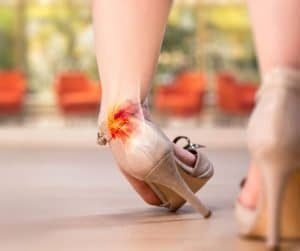
An Ankle Sprain
This blog post will discuss the key differences between strains and sprains, common treatment methods, and recovery tips.
Definition of Strains and Sprains
When it comes to musculoskeletal injuries, strains and sprains are terminologies that are commonly heard. While they may sound similar, they have distinct differences in terms of the affected structures and the nature of the injury. Understanding the definitions of strains and sprains is essential for proper diagnosis, treatment, and prevention.
Strains:
A strain refers to an injury that occurs at the muscle tendinous junction or within the muscle or tendon itself. It is often the result of overstretching or overuse of the muscle, leading to microscopic tears in the muscle fibers. Strains are commonly seen in athletes or individuals who engage in physical activities that involve repetitive movements or excessive force.
Common symptoms of a muscle strain include pain, swelling, muscle weakness, and limited range of motion. The severity of a strain can vary from mild discomfort to a complete tear of the muscle.
Sprains:
On the other hand, a sprain is an injury that affects a ligament, which is a tough band of fibrous tissue that connects bones together at a joint. Ligaments play a crucial role in providing stability and support to joints, and a sprain occurs when a ligament is stretched or torn beyond its normal capacity. Sprains commonly occur in joints such as the ankles, wrists, and knees.
Individuals with a sprain may experience symptoms such as pain, swelling, bruising, instability of the joint, and difficulty bearing weight on the affected limb. The severity of a sprain can range from mild stretching of the ligament to a complete tear.
It is important to differentiate between strains and sprains as they require different approaches to treatment and rehabilitation. Mild strains and sprains can often be managed with rest, ice, compression, and elevation (RICE therapy), along with the use of over-the-counter pain relievers. Physical therapy may also be recommended to restore strength and flexibility to the injured area.
For more severe strains or sprains that involve significant tissue damage, medical intervention such as immobilization with a splint or cast, and in some very rare cases, surgical repair may be necessary.
Prevention of Strains and Sprains:
While strains and sprains can occur unexpectedly, there are measures that individuals can take to reduce their risk of experiencing these injuries:
- Warm-up: Engage in a proper warm-up routine before physical activity to prepare the muscles and joints for exercise.
- Strength and flexibility training: Maintain strong and flexible muscles through regular strength training and mobility exercises.
- Proper technique: Use correct form and technique during physical activity to avoid placing unnecessary stress on the muscles and ligaments.
- Wear appropriate footwear: Choose footwear that provides support and stability for the activity being performed.
- Gradual progression: Gradually increase the intensity and duration of physical activity to allow the body to adapt and reduce the risk of overuse injuries.
By taking proactive steps to prevent strains and sprains, individuals can maintain their musculoskeletal health and minimise the likelihood of being sidelined by these common injuries.
Common Types of Ligament Sprains
One of the most common types of injuries that individuals experience, especially during physical activities or sports, are ligament sprains. Ligaments are tough bands of tissue that connect bones together at joints, providing stability and support for the body. When a ligament is stretched beyond its limits, it can lead to a sprain, which can range from mild to severe in terms of pain and recovery time.
Among the various types of ligament sprains that individuals can suffer from, one of the most prevalent occurs around the ankle region. Ankle sprains are particularly common due to the complex structure of the joint and its constant use in bearing the body’s weight during standing, walking, or running.
Ankle Ligament Sprains
Within the ankle joint, several ligaments can be susceptible to sprains, with the most frequent being the lateral ligaments. The lateral ligaments on the outside of the ankle include the anterior talofibular ligament (ATFL), the calcaneofibular ligament (CFL), and the posterior talofibular ligament (PTFL).
These ligaments can get overstretched or torn when the foot is twisted or turned in an unnatural angle, leading to an ankle sprain. Common causes of ankle sprains include uneven surfaces, sudden changes in direction, poor footwear, or inadequate warm-up exercises.
Symptoms of Ankle Sprains
- Pain and tenderness around the ankle joint
- Swelling and bruising
- Difficulty bearing weight on the affected foot
- Instability or weakness in the ankle
It is important to seek medical attention if you suspect an ankle sprain, as severe cases may require immobilization, physical therapy, or even surgical intervention to ensure proper healing and prevent future complications. Osteopathy and Acupuncture are both useful in helping recovery.
Prevention and Treatment
To reduce the risk of ankle sprains, individuals can take preventive measures such as wearing appropriate footwear, performing strengthening exercises for the ankle joint, and using ankle braces during high-risk activities.
In case of a sprain, the R.I.C.E. method is commonly recommended for initial treatment:
- Rest: Avoid putting weight on the injured ankle to prevent further damage.
- Ice: Apply ice packs to reduce swelling and pain in the affected area.
- Compression: Use bandages or wraps to support and stabilize the ankle.
- Elevation: Keep the injured ankle elevated above heart level to assist in reducing swelling.
Remember, proper care and attention to ligament sprains, especially around the ankle, can significantly impact recovery time and long-term joint health.
By understanding the common types of ligament sprains and taking proactive steps to prevent and address injuries, individuals can better protect their joints and overall musculoskeletal well-being.
Treatment for Strains
When it comes to treating strains, it’s important to follow a comprehensive approach that aids in quick recovery and minimizes the risk of complications. Here are some effective treatment methods that can help you bounce back from a strain:
RICE Method: Rest, Ice, Compression, and Elevation
The RICE method is a well-known and widely used approach for treating strains. Each component of RICE plays a crucial role in the healing process:
- Rest: Rest is essential to allow the affected muscle or ligament to recover. Avoiding activities that strain the injured area is key to preventing further damage.
- Ice: Applying ice to the strained area can help reduce inflammation and alleviate pain. It’s recommended to use an ice pack for 15-20 minutes every few hours in the initial days following the injury.
- Compression: Compression through bandages or wraps can help reduce swelling and provide support to the injured area. It’s important not to wrap too tightly to avoid cutting off circulation.
- Elevation: Elevating the injured limb or area above heart level can also help reduce swelling by allowing fluid to drain away from the injury site.
Gentle Range of Motion Exercises and Stretching for Recovery
Once the acute phase of the strain has passed, gentle range of motion exercises and stretching can be beneficial for promoting healing and restoring flexibility.
Remember, it’s crucial to listen to your body throughout the recovery process and not push yourself beyond your limits. Gradually reintroducing activities and exercises as per your healthcare provider’s guidance can help prevent re-injury and support a full recovery.
By following these treatment methods diligently and seeking appropriate medical advice, you can effectively manage strains and get back to your normal activities sooner.
Rest and Recovery Recommendations
When it comes to recovering from an injury or allowing your body to heal after strenuous activities, rest and recovery are key elements. Here are some important recommendations to consider:
Avoid Strenuous Activities
Depending on the severity of your injury or physical exertion, it is crucial to avoid strenuous activities for a certain period of time. This period typically ranges from 1 to 4 weeks, but it may vary based on individual circumstances and medical advice. By refraining from engaging in activities that could further strain your body, you allow it the opportunity to heal effectively.
Focus on Rest
Rest plays a critical role in the recovery process. Giving your body ample time to rest allows it to repair damaged tissues, reduce inflammation, and replenish energy stores. It is essential to listen to your body’s signals and not push yourself too hard during this period. Adequate rest is fundamental for a successful recovery journey.





